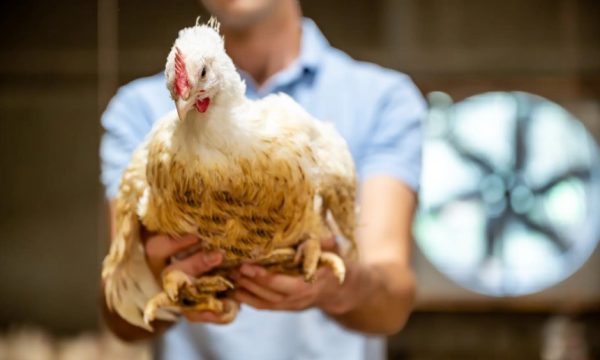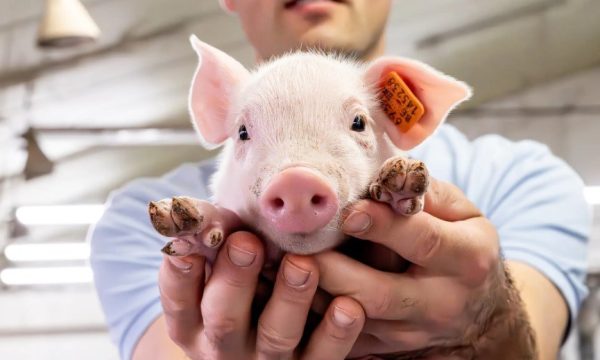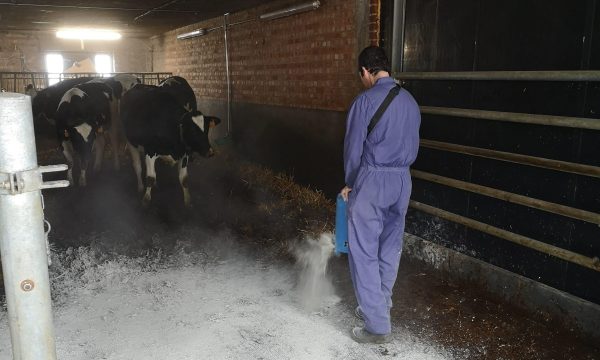Press release Reducing ammonia and especially odor emissions from the pig house by adapted ventilation

"In principle, with interventions that cost absolutely nothing, we can reduce the odor from an ordinary Flemish pig stable with a slatted floor by 34%, and the ammonia emission by 11%," says ILVO-UGent research Rafael Tabase at the end of his PhD. He carried out research into improved ventilation regimes, more specifically in modern pig houses (the so-called UFAD system or Underfloor Air Distribution System). For the measurements he combined two newly developed models and an experimental test platform where he mimicked the air movements in the house without the need for live animals to be present. Finally, he also validated his findings in the fattening pig house at the ILVO, UGent and HoGent “Pig Campus” in Melle.
In principle, with interventions that cost absolutely nothing, we can reduce the odor from an ordinary Flemish pig stable with a slatted floor by 34%, and the ammonia emission by 11%
Numerical flow mechanics is now a mature discipline that can be used in many applications", adds promoter Michel De Paepe. "In this research, by means of well validated numerical simulations, insights were obtained about ventilation of pig houses that were never obtained by experiments alone". The methodological work is therefore highly innovative and can be further used in follow-up research into the various interactions between internal air flows and emission surfaces.

Promotors Bart Sonck and Peter Demeyer are already looking ahead to further research: "From Tabase's experiments we conclude that there is still progress to be made in avoiding undesirable air exchanges between manure pit and barn space. At the same time, we need to continue to work on a construction-technically improved barn system in which critical parameters such as manure residence time, ammonia formation and the emission surface in the barn are used. Examples of this are systems in which the solid manure and urine are immediately separated and removed. This prevents the emission problem from occurring at the source".
Rafael Tabase defended online his doctorate "Impact of Ventilation on Ammonia and Odour Emissions from Pig Housing". Promotors are Prof. Dr. Michel De Paepe of UGent, Dr. Bart Sonck of UGent and ILVO and Dr. Peter Demeyer of ILVO.
Fewer emissions without additional costs?
In terms of emissions of ammonia, odor, greenhouse gases and particulate matter, intensive pig farming is subject to EU directives and regional regulations. In order to apply the European emission regulations, so-called Best Available Techniques (BAT) have been described, but in many cases they are quite costly, complex, or only work on one pollutant (or even drive other emissions up).
Rafael Tabase: "Pig farmers are looking for cheaper and easy to control emission reduction techniques, which can supplement their already applied BATs (such as low-emission barn construction concepts). My PhD research focused on reducing air emissions by adapted ventilation in pig houses with UFAD (Under Floor Air Distribution), a concept that is present in two-thirds of recent Flemish pig houses. Computer simulations suggested that you could reduce the emissions there by adapted ventilation to avoid air exchange with the manure pit".
Up to 40% less ammonia and odor
By experimenting with alternative ventilation regimes (different setting temperature for the house, different percentage of the minimum and maximum ventilation, variable setting according to the phase in the fattening round) Tabase discovered that good effects can be achieved by optimized ventilation control. "For example, increasing the so-called setting temperature from 23°C to 25°C led to a reduction of 29 to 43% of the average ammonia emission per hour". In addition, the air temperature in the ground channel proved to be a determining factor.
Methodology for specialists
To calculate the effects of the alternative ventilation regimes, Tabase used mathematical and physical modelling in combination with practical measurements.
For the indoor climate of the house a steady-state simulation model was developed, and for estimations of the transport of ammonia from the manure pit and from the floor a CFD (Computational Fluid Dynamics) model was developed. An experimental test platform was also developed at the Pig Campus in Melle, Belgium, a collaboration of ILVO, UGent and HoGent. Two pig compartments were equipped with pig models and a urea spraying system. "We simulated the heat production of the animals with artificial pigs and mimicked the urination of the pigs by spraying a urea solution on the fully slatted floors". Ultimately, the findings were validated in full-scale field experiments in which ammonia, odor and greenhouse gases (methane and nitrous oxide) were continuously measured. Naturally, pig performance was also monitored.
Conclusion: tricky to apply in practice - a different building concept is needed
Correct adjustment of a ventilation system requires a great deal of skill. It becomes particularly delicate if you want to take the right direction (reduction) in the control of ammonia, odor and greenhouse gas emissions at the same time. "The research certainly gave a promising result for odor", says promoter Bart Sonck. "We also saw a reduction in ammonia, but further research is needed here. I am thinking of heating the soil channel in winter so that there is no cold air in the manure pit, or cooling in summer so that the ventilation flows can be reduced".
When it comes to practical applications, the researchers remain cautious. "The greatest added value of Raphael Tabase's research lies in the methodological development of good tools, which can be used even more widely in the future. As far as current practice is concerned, however, we have to remain realistic: unfortunately, in this building concept it remains very difficult to achieve significant and demonstrable emission reductions in practice. The internal air flows and the risk of the so-called well exchange are different for each barn, and they are also very subject to the temperature of the air inlet. In addition to looking for solutions for existing UFAD-ventilated barns, we must therefore also focus on the design of new barn concepts. A better option may be a preventive approach closer to the source, where you focus on the quick separation of solid manure and urine. This prevents ammonia formation, together with smaller manure residence times and emission surfaces in the barn".


